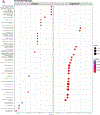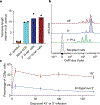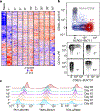Functional T cells are capable of supernumerary cell division and longevity
- PMID: 36653453
- PMCID: PMC11617068
- DOI: 10.1038/s41586-022-05626-9
Functional T cells are capable of supernumerary cell division and longevity
Abstract
Differentiated somatic mammalian cells putatively exhibit species-specific division limits that impede cancer but may constrain lifespans1-3. To provide immunity, transiently stimulated CD8+ T cells undergo unusually rapid bursts of numerous cell divisions, and then form quiescent long-lived memory cells that remain poised to reproliferate following subsequent immunological challenges. Here we addressed whether T cells are intrinsically constrained by chronological or cell-division limits. We activated mouse T cells in vivo using acute heterologous prime-boost-boost vaccinations4, transferred expanded cells to new mice, and then repeated this process iteratively. Over 10 years (greatly exceeding the mouse lifespan)5 and 51 successive immunizations, T cells remained competent to respond to vaccination. Cells required sufficient rest between stimulation events. Despite demonstrating the potential to expand the starting population at least 1040-fold, cells did not show loss of proliferation control and results were not due to contamination with young cells. Persistent stimulation by chronic infections or cancer can cause T cell proliferative senescence, functional exhaustion and death6. We found that although iterative acute stimulations also induced sustained expression and epigenetic remodelling of common exhaustion markers (including PD1, which is also known as PDCD1, and TOX) in the cells, they could still proliferate, execute antimicrobial functions and form quiescent memory cells. These observations provide a model to better understand memory cell differentiation, exhaustion, cancer and ageing, and show that functionally competent T cells can retain the potential for extraordinary population expansion and longevity well beyond their organismal lifespan.
© 2023. The Author(s), under exclusive licence to Springer Nature Limited.
Conflict of interest statement
Figures







Comment in
-
CD8 T cells are forever.Sci Immunol. 2023 Feb 3;8(80):eadg8279. doi: 10.1126/sciimmunol.adg8279. Epub 2023 Feb 3. Sci Immunol. 2023. PMID: 36735775
-
Age is just a number: long-lasting T-cell immunity can span several lifetimes.Immunol Cell Biol. 2023 May;101(5):374-376. doi: 10.1111/imcb.12632. Epub 2023 Mar 5. Immunol Cell Biol. 2023. PMID: 36798971
-
T cells last longer than mice.Nat Immunol. 2023 Mar;24(3):377. doi: 10.1038/s41590-023-01456-7. Nat Immunol. 2023. PMID: 36829071 No abstract available.
References
-
- Stanley JF, Pye D. & MacGregor A. Comparison of doubling numbers attained by cultured animal cells with life span of species. Nature 255, 158–159 (1975). - PubMed
-
- Bodnar AG et al. Extension of life-span by introduction of telomerase into normal human cells. Science 279, 349–352 (1998). - PubMed
-
- Masopust D, Ha S-J, Vezys V. & Ahmed R. Stimulation history dictates memory CD8 T cell phenotype: implications for prime-boost vaccination. J. Immunol 177, 831–839 (2006). - PubMed
-
- Kunstyr I. & Leuenberger HG Gerontological data of C57BL/6J mice. I. Sex differences in survival curves. J. Gerontol 30, 157–162 (1975). - PubMed
Publication types
MeSH terms
Substances
Grants and funding
LinkOut - more resources
Full Text Sources
Other Literature Sources
Molecular Biology Databases
Research Materials

